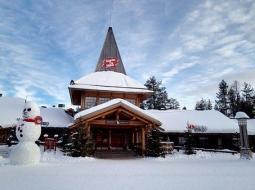Thessaloniki gets ready for its metro launch in November
The underground rapid transit lines have been under construction for almost two decades due to various project delays
 TheMayor.EU logo
TheMayor.EU logo 
Periodic clearance of new land for agriculture and the practice of slash-and-burn cultivation began around 750–530 BC. Artifacts found in the area suggest that an increasing number of travellers from Karelia in the east, Häme in the south and the Arctic Ocean coast in the north must have come there from 500 AD onwards. The Sami are considered to be Lapland`s most indigenous existing population.
Rovaniemi is first mentioned by name in official documents in 1453, existing effectively as a set of small villages whose inhabitants earned their living mainly in agriculture and animal husbandry with fishing and hunting the most important offshoots.
The exploitation of Lapland's natural resources in the 1800s boosted Rovaniemi's growth. Extensive logging sites and gold fever attracted thousands of people to Lapland. As the mining of natural resources was increased, Rovaniemi became the business centre of the province of Lapland.
During the Second World War, Finland signed the Moscow Armistice and found itself involved in the Lapland War with its former German ally. Retreating German forces utilised scorched earth tactics, and though initially German General Lothar Rendulic ordered only the public buildings in Rovaniemi to be destroyed, on 13 October 1944 the German army received orders to destroy all the buildings in Rovaniemi, only excluding hospitals and houses where inhabitants were present. While the German rear guard was going about the destruction, an ammunition train in Rovaniemi station exploded and set fire to the wooden houses of the town. The German troops suffered many casualties, mainly from glass splinters. A Finnish commando unit claimed to have blown up the ammunition train and may well have been the primary cause of the town's ruin. The cause was then unknown and generally assumed to be the deliberate intent of Rendulic. During these hostilities 90% of all the buildings in Rovaniemi were destroyed. There is a German cemetery 19 km from Rovaniemi where soldiers killed fighting in Lapland during the war are buried.
Rovaniemi is the administrative capital and commercial centre of Finland's northernmost province, Lapland. It is situated about 6 kilometres south of the Arctic Circle and is between the hills of Ounasvaara and Korkalovaara, at the confluence of the river Kemijoki and its tributary, the Ounasjoki. The city and the surrounding Rovaniemen maalaiskunta (Rural municipality of Rovaniemi) were consolidated into a single entity on 1 January 2006. The new municipality has an area of 8,016.75 square kilometres, thus making it the largest city in the European Union by land. Rovaniemi has an approximate population of 62,000.
Rovaniemi is the leading Arctic Tourism City globally. Because of the unspoiled nature of the area and numerous recreational opportunities, tourism is an important part of the economy of Rovaniemi. The city has a number of hotels and restaurants located both in the centre and on the outskirts of the town.
Rovaniemi has two trademarks: Official Home Town of Santa Claus and Arctic Design Capital.

Rovaniemi's most prominent landmarks include the Jatkankynttila bridge with its eternal flame over the Kemijoki river, the Arktikum House which rises out of the bank of the Ounasjoki river, the Rovaniemi Town Hall, the Lappia House which serves as a theatre, concert hall and congress centre, and the library.
Rovaniemi is considered by Finns to be the official home town of Santa Claus and is home to the Santa Claus Village at the Arctic Circle and Santa Park, which is located 8 km north of the centre. The Arktikum is a very comprehensive museum of Finland's and the world's Arctic regions.
Directly across the river from the town is the Ounasvaara ski centre. The top of the Ounasvaara hill bears the site of some of the earliest known human settlements in the area.
A phenomenon also attracting numerous tourists is the Aurora Borealis or Northern Lights. In Finnish Lapland the number of auroral displays can be as high as 200 a year whereas in southern Finland the number is usually fewer than 20.
Address: Hallituskatu 7, PH 8216, 96101 Rovaniemi